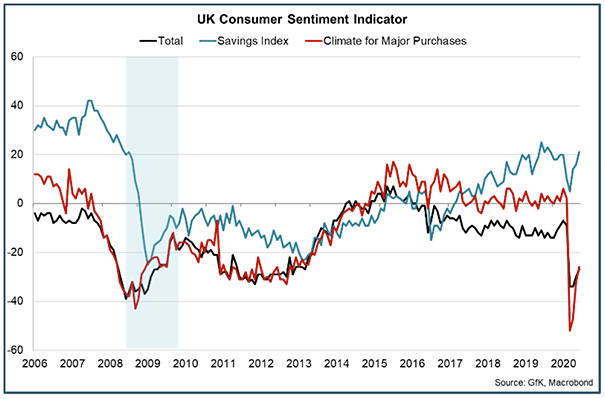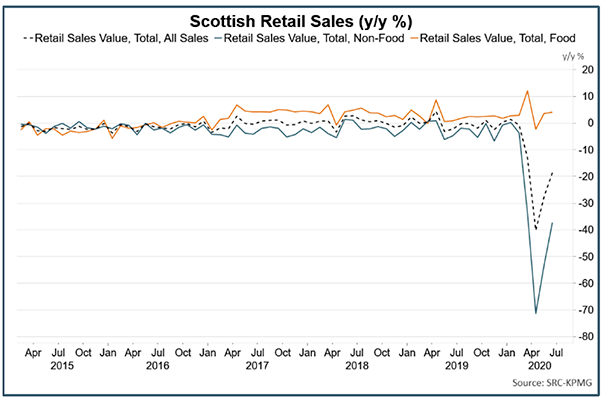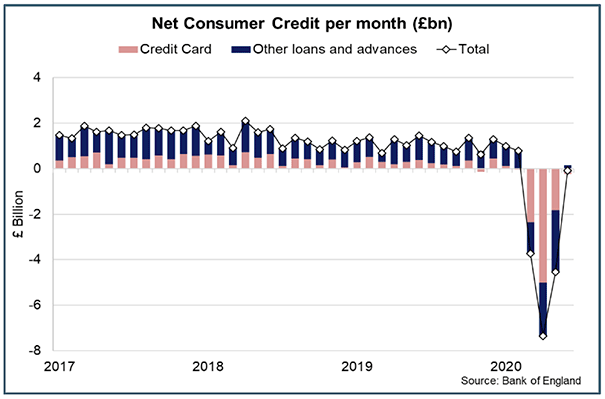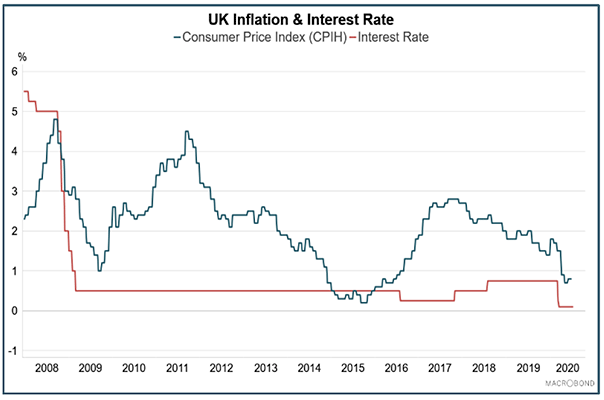Monthly economic brief: August 2020
Provides a summary of latest key economic statistics, forecasts and analysis on the Scottish economy.
This document is part of a collection
Consumption
Lockdown restrictions have had a significant impact on consumer sentiment and consumption activity which have shown some early signals of stabilising as restrictions have eased.
Consumer sentiment
- UK consumer sentiment fell sharply during lockdown, reflecting weaker expectations about the performance of the economy and personal household finances.
- UK consumer sentiment improved slightly in July as the economy continued to reopen, however remained low at -27.[20]
- Compared to June, households in July reported small improvements in economic and household financial expectations for the next 12 months and a pick-up in attitudes towards savings and major purchases.

Figure Description
This chart shows a time series from 2006 up to July 2020 of UK households attitudes toward savings, appetite for major purchases and perceptions of overall consumer sentiment. Overall consumer sentiment consists of a combination of household perceptions regarding their current and expected personal financial situation and the economic performance as well as their attitudes towards savings and appetite for major purchases.
Retail sales
- Scottish Retail Consortium data[21] on retail sales for June reported an annual decrease of -19% in total retail sales in Scotland, easing from the fall in May (-28%) and the record fall in April (-40.3%).
- The decline in retail sales in June was mainly driven by a fall in non-food retail sales. Over the year to June, non-food retail sales fell by 37%, while food retail sales increased by 4%.
- The combination of lockdown measures, increased pressure on incomes and weaker sentiment are factors that likely drove the continued fall in retail sales in June compared to last year. However the softer decline compared to April and May is consistent with the easing of consumer sentiment and business activity indicators as lockdown restrictions started to ease.

Figure Description
This chart shows the annual percentage change in total Scottish retail sales, non-food retail sales and food retail sales between April 2015 and July 2020.
Consumer lending and repayment[22]
- While consumer spending has fallen sharply during lockdown, likely reflecting a combination of essential retail closure and weaker sentiment regarding the outlook, the CJRS has been supporting incomes of those on furlough whilst those employed in sectors that are more able to work from home have continued to receive their usual income. This has in part been reflected in people repaying more consumer credit than they have been taking on in new borrowing.
- Households' consumer credit borrowing recovered a little in June, following three particularly weak months. On net, households repaid £15.6 billion of consumer credit in the three months to May.
- Households made a small net repayment in June (£86 million), suggesting that consumer spending remained weak.

Figure Description
This chart shows the total net UK consumer credit per month since 2017. Total net consumer credit per month is built up of two components, credit card consumer credit and other loans and advances.
Inflation and interest rate
- The collapse in demand, alongside the fall in oil price to record lows has placed downward pressure on inflation in the first half of 2020.
- The Consumer Prices Index including owner occupiers' housing costs (CPIH) 12-month inflation rate was 0.8% in June 2020, up from 0.7% in May 2020 but down from 1.8% at the start of the year.[23]
- Key contributions to the latest increase in the inflation rate came from rising prices for games and clothing which was partially offset by falling prices for food.
- The Bank of England maintained the Bank Rate at 0.1% in August 2020[24] and in their current central scenario analysis project inflation to fall to 0.25% in 2020 before rising to 1.75% in 2021 and 2% in 2022.

Figure Description
This chart shows the UK Consumer Price Index including owned occupiers’ housing costs 12-month inflation rate and interest rate from 2008 to June 2020.
Contact
Email: OCEABusiness@gov.scot
There is a problem
Thanks for your feedback